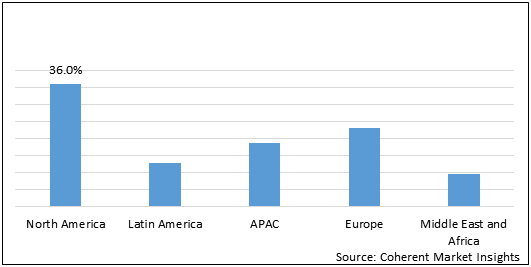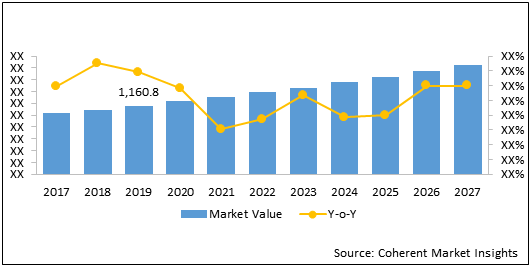Fiber optics are thin, long strands of very pure glass, arranged in bundles that are used to translate light signals over long distances. Various medical instruments utilize fiber optics for several applications including laser signal delivery, illumination, and image transfer. Generally, medical fiber optics applications include X-ray imaging, light therapy, dental handpieces, ophthalmic lasers, diagnostic instrumentation, endoscopy, and surgical microscopy. Different types of fibers are used such a pure silica fiber, polycrystalline fiber, and polymer optical. Medical fiber optics are used in hospitals, diagnostic laboratories, contract research organizations, ambulatory surgical centers, specialty clinics, etc.
The global medical fiber optics market is estimated to account for US$ 1,855.2 Mn in terms of value by the end of 2027.
Market Dynamics- Drivers
MIS refers to a medical surgery, which performed through small incisions rather than large incisions. Since there is reduced blood loss, these surgical procedures are gaining major traction in hospitals and clinics worldwide. Furthermore, MIS offers shorter hospital stays, fewer complications, and low cost. For these surgeries, fiber optics are used as they are highly flexible, light, and can be placed in tight spaces highly localized measurements. Hence, these factors are expected to drive growth of the global medical fiber optics market during the forecast period.
The prevalence of gastrointestinal and digestive diseases has increased significantly in the recent past in both developed and emerging economies. According to the Centers for Disease Control and Prevention (CDC), in 2019, there were around 14.8 million adults in the U.S. diagnosed with ulcers. Ulcer is a type of gastrointestinal disease and in severe cases, it requires surgical procedures. Medical fiber optics can be used in diagnosis and analysis of ulcers, which in turn, is expected to propel the global medical fiber optics market growth in the near future.
Statistics:
North America held dominant position in the global medical fiber optics market in 2019, accounting for 36.0% share in terms of value, followed by Europe, APAC, Latin America, and MEA respectively.
Figure 1: Global Medical Fiber Optics Market Share (%), in terms of Value, By Region, 2019

To learn more about this report, Request sample copy
Market Dynamics- Restraints
Many medical professionals and patients are preferring non-invasive diagnostics and monitoring methods for obvious reasons. These methods include glucose concentration, hemodynamic monitoring, X-rays, EKG, ECG, etc. As a result of this, the demand for medical fiber optics has declined significantly. Therefore, these factors are expected to restrain growth of the market in the near future.
There still remains a major issue of integrating novel technology in healthcare industry that can help physicians to diagnose and monitor patients efficiently. Moreover, solution providers offer various devices that are compatible with certain optical fibers due to technical specifications and requirements. Hence, these factors are expected to hamper the market growth over the forecast period.
Medical Fiber Optics Market Report Coverage
| Report Coverage | Details | ||
|---|---|---|---|
| Base Year: | 2019 | Market Size in 2019: | US$ 1,160.8 Mn |
| Historical Data for: | 2016 to 2019 | Forecast Period: | 2020 to 2027 |
| Forecast Period 2020 to 2027 CAGR: | 6.0% | 2027 Value Projection: | US$ 1,855.2 Mn |
| Geographies covered: |
|
||
| Segments covered: |
|
||
| Companies covered: |
Leoni AG, Sunoptic Technologies LLC, Gulf Fiberoptics, Inc., Integra LifeSciences Holdings Corporation, Coherent, Inc., Molex Incorporated, Fiberoptics Technology, Inc., Newport Corporation, and Schott AG. |
||
| Growth Drivers: |
|
||
| Restraints & Challenges: |
|
||
Uncover macros and micros vetted on 75+ parameters: Get instant access to report
Market Opportunities
Key companies in the market are focused on research and development activities, in order to innovate novel products. For instance, in June 2015, Leoni introduced radiation-resistant multi-mode fibers for computer tomography applications. These fibers are IEC 60332-1-2 and IEC 60332-3-22 Cat. A compliant. Moreover, in June 2015, Leoni introduced radiation-resistant multi-mode fibers for computer tomography applications.
Key market players are focused on business and capacity expansion, in order to enhance the market presence. For instance, in March 2015, Schott AG expanded its Puravis glass optical fiber solutions by introducing rigid fiber rods for dental devices applications.
Figure 2: Global Medical Fiber Optics Market Value (US$ Mn), 2017 - 2027

To learn more about this report, Request sample copy
The global medical fiber optics market was valued at US$ 1,160.8 Mn in 2019 and is forecast to reach a value of US$ 1,855.2 Mn by 2027 at a CAGR of 6.0% between 2020 and 2027.
Market Trends
Among regions, North America is expected to witness significant growth in the global medical fiber optics market during the forecast period. This is owing to high presence of major manufacturers across the U.S. Furthermore, technological advancements and rising foreign investment are expected to boost the regional market growth over the forecast period.
Europe is expected to register a robust growth rate in the global medical fiber optics market over the forecast period. This is owing to strong industrial growth across the region. Furthermore, increasing surgical procedures in developed countries such as Germany, France, and the U.K. is expected to propel the regional market growth in the near future.
Regulations
USP Class Testing
The United States Pharmacopeia (USP) is a non-government organization that focuses primarily on setting standards to safeguard the quality of medicines and other health care technologies. This organization focuses on bio-technology and pharmaceutical industries. The USP sets standards for strength, purity, quality and consistency of various products. These standards are published in the National Formulary (USP NF) and US Pharmacopeia. The USP defines six classes, from I to VI, where USP class VI being the most stringent. Plastic manufacturers that utilize plastic resins as raw materials for manufacturing medical devices and components require these raw materials to be certified as USP Class VI in order to produce favorable biocompatibility results.
Global Medical Fiber Optics Market- Impact of Coronavirus (Covid-19) Pandemic
According to Coherent Market Insights’ analysis, the impact of coronavirus (COVID-19) pandemic on the medical fiber optics is moderate. Due to lockdown in countries such as China and India, supply chain is mainly disturbed. Furthermore, many key players in the market remains operational with limited people working on the shop floor and remaining people are working from home, which lowered the production capacity of the factory. For instance, in April 2020, Coherent, Inc., a US based electronics component manufacturing company implemented COVID 19 regulations such as social distancing norm, for employees working in the factory floor. Further company provided work from facility to the remaining employees to combat COVID 19. This has affected ongoing activities in the industry however, there is expected to be significant growth in the market post COVID.
Competitive Section
Key players operating in the global medical fiber optics market Leoni AG, Sunoptic Technologies LLC, Gulf Fiberoptics, Inc., Integra LifeSciences Holdings Corporation, Coherent, Inc., Molex Incorporated, Fiberoptics Technology, Inc., Newport Corporation, and Schott AG.
Key Developments
Share
Share
Missing comfort of reading report in your local language? Find your preferred language :
Transform your Strategy with Exclusive Trending Reports :
Frequently Asked Questions
Select a License Type
Credibility and Certifications

860519526

9001:2015
27001:2022


Joining thousands of companies around the world committed to making the Excellent Business Solutions.
View All Our Clients
US Reciprocal Tax Impact Analysis On Medical Fiber Optics Market
Stay updated on tariff changes with expert insights and timely information